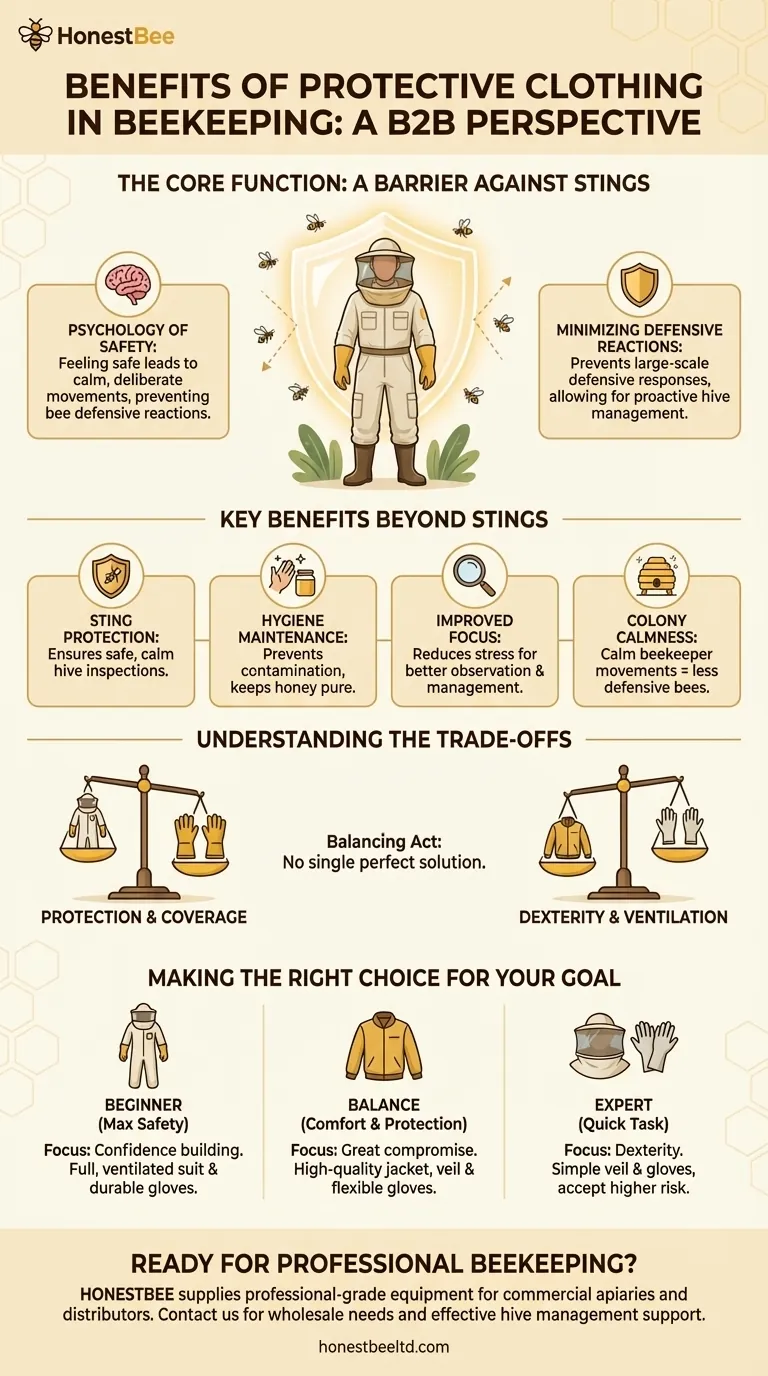The primary benefit of wearing protective clothing in beekeeping is to serve as a physical barrier against bee stings. This protection allows a beekeeper to work calmly and effectively, reduces the risk of painful encounters, and helps maintain a hygienic environment for the hive by preventing the transfer of outside contaminants.
Protective gear is not just about avoiding stings; it is a critical tool for creating a safe, controlled environment. This enables you to be a more confident and observant beekeeper, which in turn keeps your bees calmer and healthier.

The Core Function: A Barrier Against Stings
The most obvious role of beekeeping gear is defense. Understanding why this is so critical reveals its impact on both the beekeeper and the bees.
The Psychology of Safety
When you feel safe, your movements are calmer and more deliberate. This sense of security is vital, as sudden, jerky motions can be interpreted as a threat by bees, triggering a defensive response.
Protective clothing provides the peace of mind necessary to focus on the task at hand, whether it's inspecting a frame for the queen or checking for pests. This makes the entire experience more enjoyable and less stressful.
Minimizing Defensive Reactions
Bees sting when they perceive a threat to their colony. A proper bee suit, veil, and gloves create a shield that allows you to perform necessary hive inspections without initiating a large-scale defensive reaction from the colony.
This barrier allows you to manage the hive's health proactively rather than reacting to problems after they've become severe.
Beyond Stings: The Secondary Benefits
While sting prevention is the main goal, dedicated beekeeping clothing offers other important advantages that contribute to a healthy and productive apiary.
Maintaining Apiary Hygiene
Your everyday clothes can carry fibers, dirt, pet hair, and other contaminants. Wearing a dedicated, clean bee suit or jacket prevents these foreign materials from being introduced into the hive.
This helps protect the bees from potential harm and ensures the honey remains pure and uncontaminated.
Enabling Calm and Focused Work
Without the constant distraction or fear of being stung, you can fully concentrate on observing the colony. This focus is essential for identifying subtle cues about the hive's health, population, and productivity.
A calm beekeeper is an effective beekeeper. The confidence your gear provides directly translates into better hive management.
Understanding the Trade-offs
Choosing the right protective gear involves balancing complete protection with comfort and dexterity. No single solution is perfect for every situation.
Protection vs. Dexterity
Thick gloves made of leather or rubber offer maximum protection but can make delicate tasks, like marking a queen or handling a single frame, feel clumsy.
Lighter gloves made from materials like goatskin provide a better feel and more dexterity but offer slightly less protection against a determined sting.
Full Suit vs. Jacket
A full bee suit offers head-to-toe protection and ensures there are no gaps for bees to enter. This is often the best choice for beginners to build confidence. However, they can be hot in warm climates.
A bee jacket provides excellent upper-body and head protection while offering more ventilation. This must be paired with thick, long pants and proper footwear to ensure full coverage.
Experience and Risk Tolerance
As beekeepers gain experience, they learn to read their bees' temperament. Some may choose to work barehanded for certain quick tasks to improve dexterity, having accepted the higher risk of a sting. This is a personal choice that should only be made after significant experience.
Making the Right Choice for Your Goal
Your choice of protective gear should align with your experience level and the specific task you are performing.
- If your primary focus is maximum safety as a beginner: Choose a full, ventilated bee suit with durable gloves to build confidence and ensure a positive early experience.
- If your primary focus is balancing comfort and protection: A high-quality bee jacket and veil, paired with thick canvas pants and flexible goatskin gloves, offers a great compromise.
- If your primary focus is a quick inspection as an expert: A simple veil and gloves may be sufficient, but only if you are familiar with the specific hive's temperament and accept the risks.
Ultimately, the right protective clothing transforms beekeeping from an intimidating prospect into a focused and rewarding practice.
Summary Table:
| Benefit | Key Impact |
|---|---|
| Sting Protection | Creates a physical barrier for safe, calm hive inspections. |
| Hygiene Maintenance | Prevents contamination of the hive from outside materials. |
| Improved Focus | Reduces stress, allowing for better observation and management. |
| Colony Calmness | Calm beekeeper movements lead to less defensive bee behavior. |
Ready to work with confidence and protect your apiary?
HONESTBEE supplies professional-grade beekeeping supplies and equipment to commercial apiaries and beekeeping equipment distributors through wholesale-focused operations. Our protective gear is designed to provide the safety and comfort you need for effective hive management.
Contact HONESTBEE today to discuss your wholesale needs and discover how our equipment can support your beekeeping success.
Visual Guide

Related Products
- Cotton Beekeeping Suit and Round Hat with Veil Bee Keeper Protective Gear
- Beekeeping Jacket with Hood and Veil for Beekeepers
- Economy Polyester Beekeeping Jacket with Veil and Hat
- Heavy Duty Cowboy Beekeeper Hat with Visibility Veil Outdoor Professional Beekeeping Protective Gear
- Beekeeper Cowboy Hat and Veil for Beekeeping
People Also Ask
- What are bee suits made of? Choosing the Right Material for Maximum Protection & Comfort
- How should a bee suit be cleaned? Protect Your Investment and Ensure Apiary Safety
- What is recommended for beginners in beekeeping regarding protective clothing? A Complete Safety Guide for New Beekeepers
- How should a beekeeping suit be hung to maintain its shape? Protect Your Investment with Proper Storage
- Why is white the predominant color in bee suit designs? | Key to Hive Calm & Beekeeper Safety



















